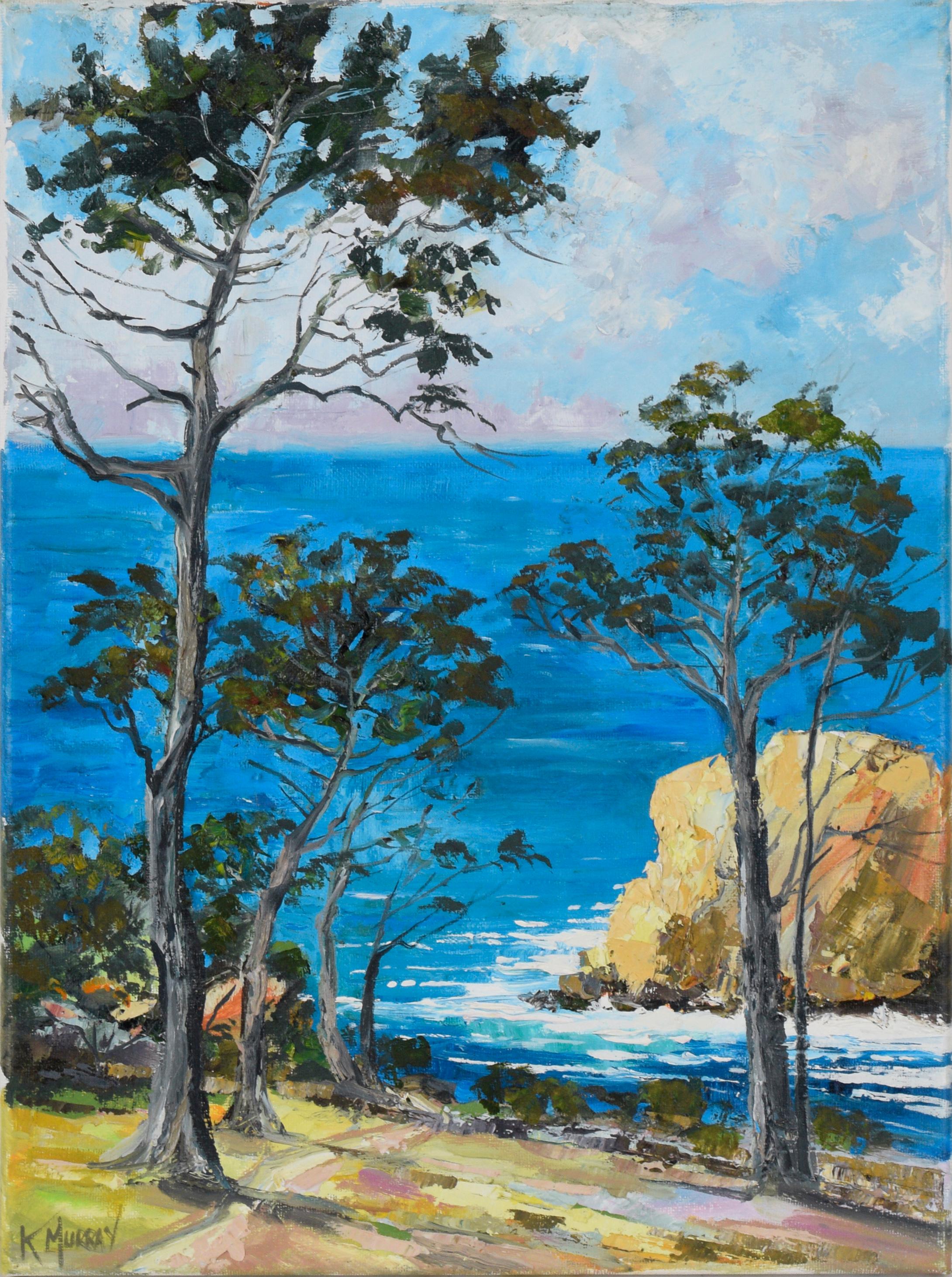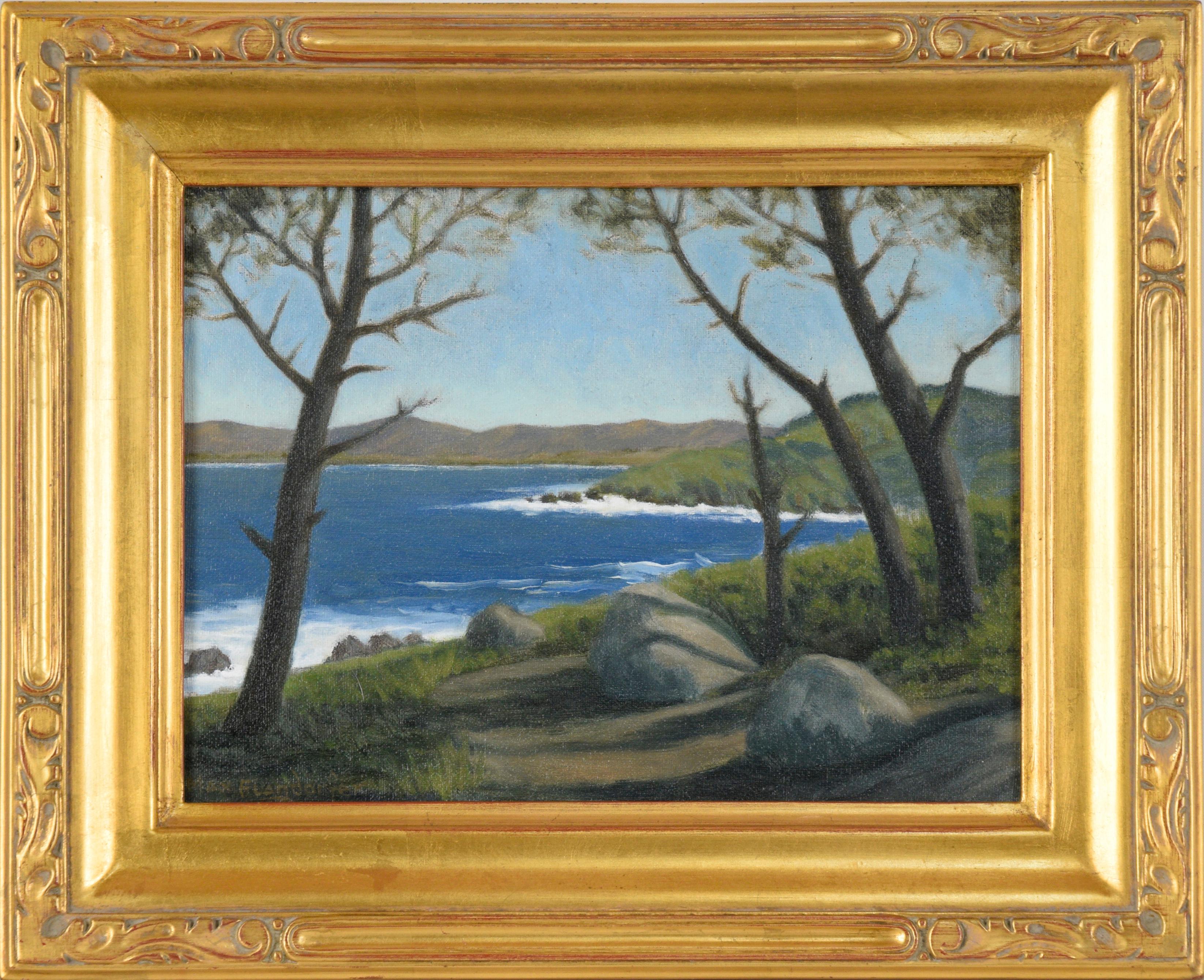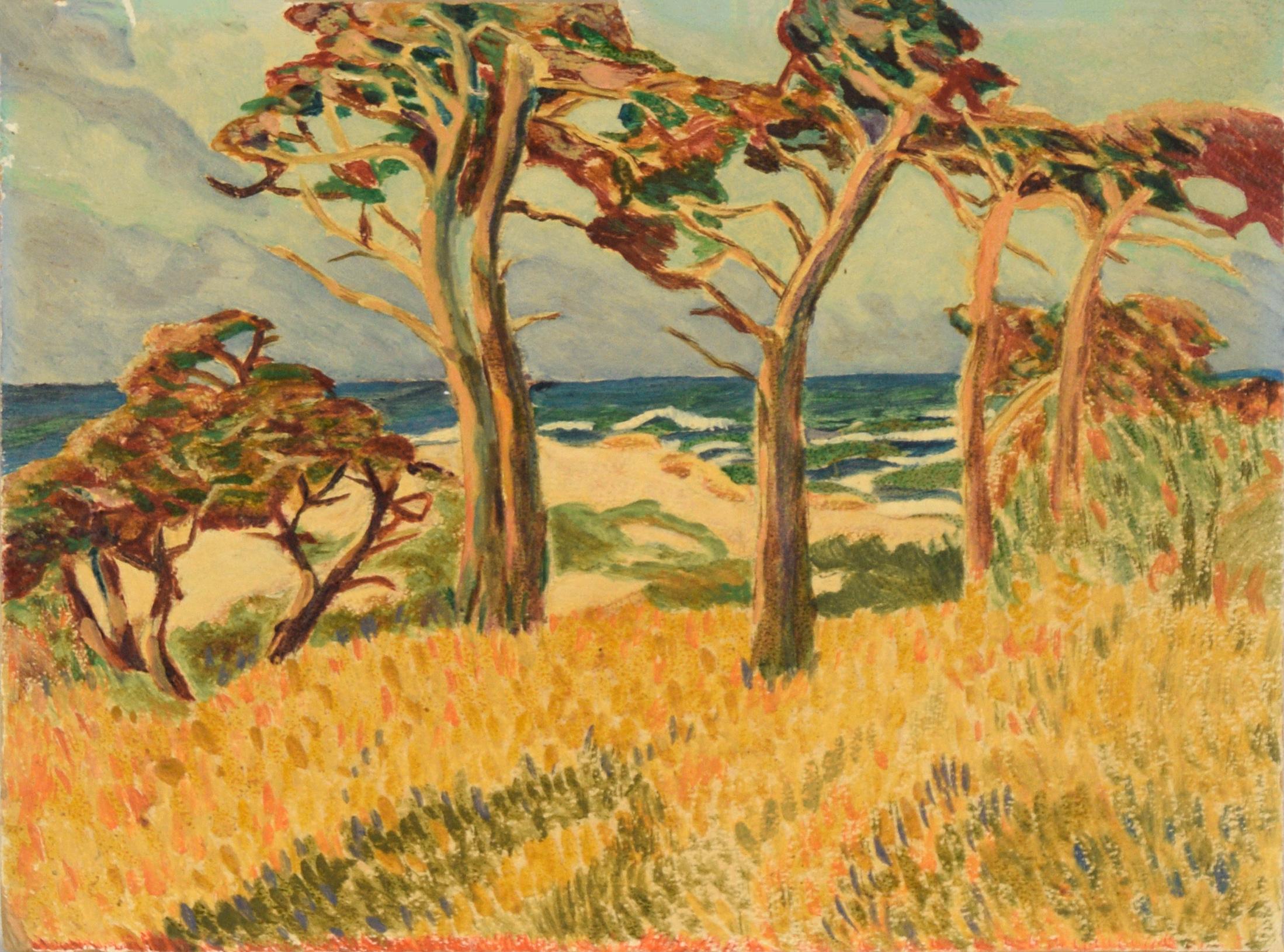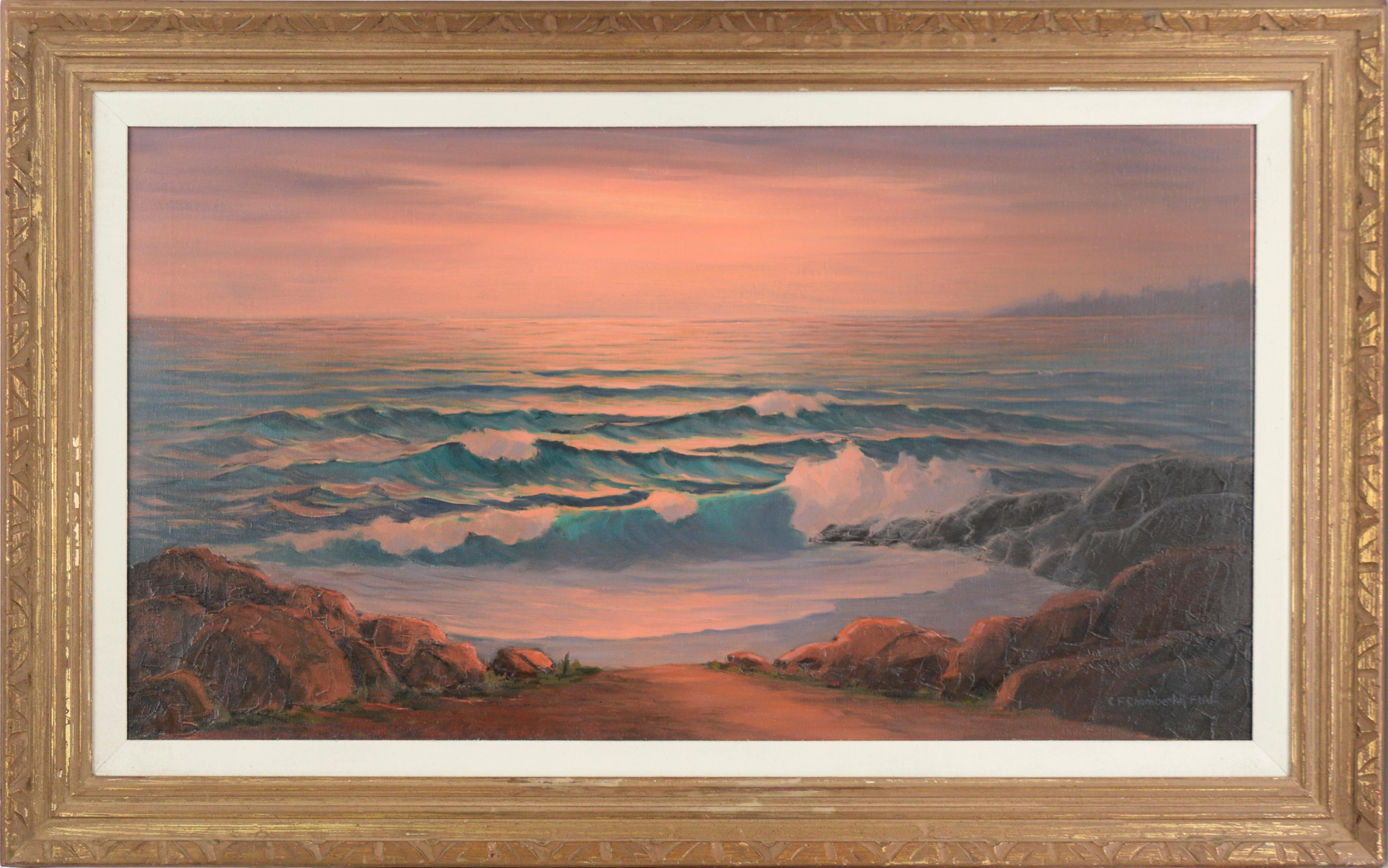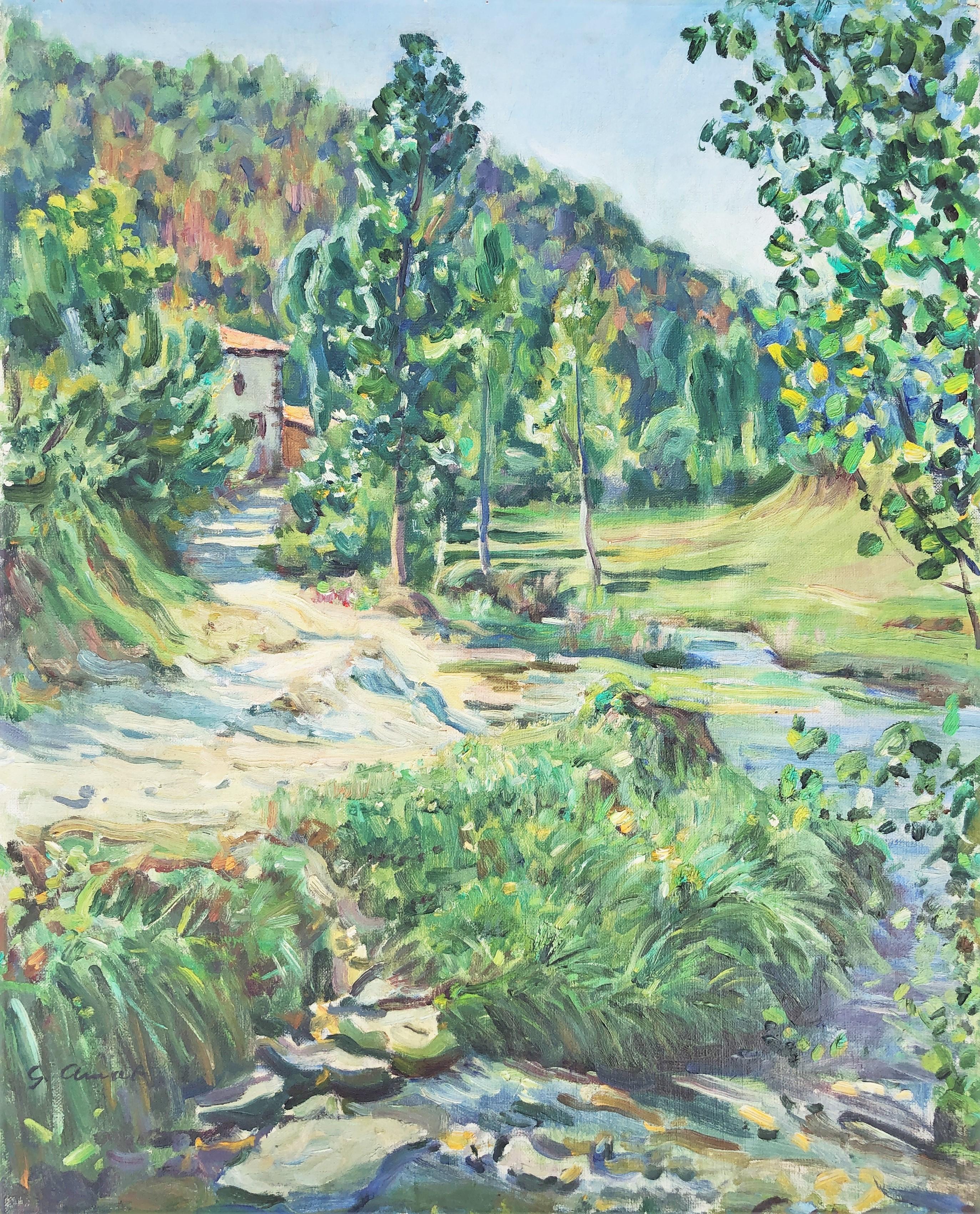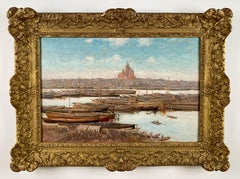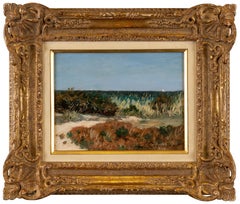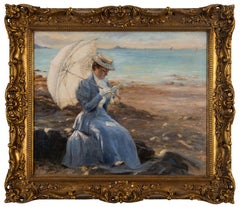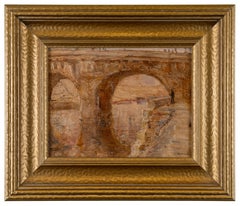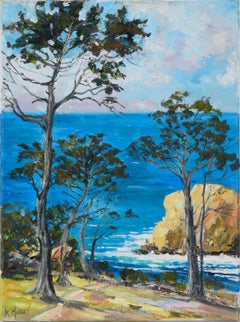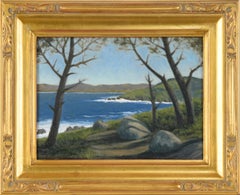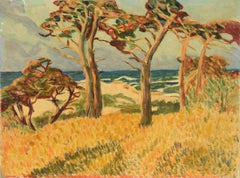Items Similar to Morning in the Village
Want more images or videos?
Request additional images or videos from the seller
1 of 8
Henry Ward RangerMorning in the Village
About the Item
Henry Ward Ranger
American, 1858-1915
Morning In the Village
Oil on Academy Board
12 by 16 in, w/ frame 19 ¼ by 23 ¼ in
Signed lower right
A key person in the establishment of the Old Lyme, Connecticut art colony in 1899, Henry Ward Ranger is regarded as the leader of the Tonalist movement in America and was a leading painter in this country in the late 19th and early 20th-centuries.
He was born in Geneseo and raised in Syracuse, New York, and in 1873, enrolled in the College of Fine Arts at Syracuse University, where his father was a professor of photography and drawing. Two years later, he became a re-toucher of paintings in his father's studio and did not earn a college degree.
He also spent much time in New York City, where he was a writer of music criticism and visited galleries, where he had his first exposure to French Barbizon painting. During much of the 1880s, he painted watercolors of marine subjects, and exhibited those in New York City, Boston, and Paris.
As a student in France, he became greatly interested in the Barbizon School of painters, and then a trip to The Hague, Holland, was even more influential when he met a large colony of Dutch painters called "The Hague School", whose emphasis was on Realism and Tonalism.
Their soft, Atmospheric and Tonalist style of sombre colors seemed to suit him. However, his soft colors later became a special problem for anyone trying to restore his paintings as it was difficult to distinguish original color from soil on canvases. He did his sketches "en plein air" but finished his paintings in his studio and often exhibited his sketches and paintings together.
In 1885, Ranger moved to New York City and took up easel painting increasingly favoring oils over watercolors. In 1892, he had a one-man exhibition at the Knoedler Galleries in New York City. Many of his works in that show were forest interiors and tree studies.
Gradually his palette lightened with color and luminosity suggesting the influence of George Inness. In the summer of 1899, Ranger discovered Florence Griswold's boardinghouse in Old Lyme, Connecticut, and he returned in the summer of 1900. With his influence and the friendship of Florence Griswold, he became the leader of the artists' colony of Old Lyme, "an American version of Barbizon" (Lowrey 162) for three years.
However, the prevalent style changed to Impressionism with the 1903 arrival of Childe Hassam. He became disenchanted with painting at Old Lyme with the arrival of Childe Hassam in 1903 and the subsequent influence of his Impressionist style. In protest of the plein-air, fast painting, and lightened palette and abstraction of these Impressionists, Ranger, in 1905, moved farther down the coast to Noank, Connecticut near the mouth of the Mystic River.
Like many of his associates, he also maintained a studio in New York City where he was very prominent and often lectured and wrote about art and took an active part in the art community. He was a member of the National Academy of Design and the National Arts Club, and he wrote articles about art that were published.
When Henry Ward Ranger died in 1916, he was a childless widower and left his estate to the National Academy of Design to establish the Ranger Fund whose income was to purchase the works of living American artists beyond the age of forty-five.
- Creator:Henry Ward Ranger (1858 - 1916, American)
- Dimensions:Height: 19.25 in (48.9 cm)Width: 23.25 in (59.06 cm)
- More Editions & Sizes:19 ¼ by 23 ¼ inPrice: $3,400
- Medium:
- Movement & Style:
- Period:
- Condition:
- Gallery Location:Sheffield, MA
- Reference Number:Seller: 015661stDibs: LU700315922622
Henry Ward Ranger
A key person in the establishment of the Old Lyme, Connecticut art colony in 1899, Henry Ward Ranger is regarded as the leader of the Tonalist movement in America and was a leading painter in this country in the late 19th and early 20th-centuries. He was born in Geneseo and raised in Syracuse, New York, and in 1873, enrolled in the College of Fine Arts at Syracuse University, where his father was a professor of photography and drawing. Two years later, he became a re-toucher of paintings in his father's studio and did not earn a college degree. He also spent much time in New York City, where he was a writer of music criticism and visited galleries, where he had his first exposure to French Barbizon painting. During much of the 1880s, he painted watercolors of marine subjects, and exhibited those in New York City, Boston, and Paris. As a student in France, he became greatly interested in the Barbizon School of painters, and then a trip to The Hague, Holland, was even more influential when he met a large colony of Dutch painters called "The Hague School", whose emphasis was on Realism and Tonalism. Their soft, Atmospheric and Tonalist style of sombre colors seemed to suit him. However, his soft colors later became a special problem for anyone trying to restore his paintings as it was difficult to distinguish original color from soil on canvases. He did his sketches "en plein air" but finished his paintings in his studio. In 1885, Ranger moved to New York City and took up easel painting increasingly favoring oils over watercolors. In 1892, he had a one-man exhibition at the Knoedler Galleries in New York City. Many of his works in that show were forest interiors and tree studies. Gradually his palette lightened with color and luminosity suggesting the influence of George Inness. In the summer of 1899, Ranger discovered Florence Griswold's boardinghouse in Old Lyme, Connecticut, and he returned in the summer of 1900. With his influence and the friendship of Florence Griswold, he became the leader of the artists' colony of Old Lyme, "an American version of Barbizon" for three years. However, the prevalent style changed to Impressionism with the 1903 arrival of Childe Hassam. He became disenchanted with painting at Old Lyme with the arrival of Childe Hassam in 1903 and the subsequent influence of his Impressionist style. In protest of the plein-air, fast painting, and lightened palette and abstraction of these Impressionists, Ranger, in 1905, moved farther down the coast to Noank, Connecticut near the Mystic River. Like many of his associates, he also maintained a studio in New York City where he was very prominent and often lectured and wrote about art and took an active part in the art community. He was a member of the National Academy of Design and the National Arts Club, and he wrote articles about art that were published.
About the Seller
3.7
Vetted Professional Seller
Every seller passes strict standards for authenticity and reliability
1stDibs seller since 2017
51 sales on 1stDibs
Typical response time: 18 hours
- ShippingRetrieving quote...Shipping from: Sheffield, MA
- Return Policy
Authenticity Guarantee
In the unlikely event there’s an issue with an item’s authenticity, contact us within 1 year for a full refund. DetailsMoney-Back Guarantee
If your item is not as described, is damaged in transit, or does not arrive, contact us within 7 days for a full refund. Details24-Hour Cancellation
You have a 24-hour grace period in which to reconsider your purchase, with no questions asked.Vetted Professional Sellers
Our world-class sellers must adhere to strict standards for service and quality, maintaining the integrity of our listings.Price-Match Guarantee
If you find that a seller listed the same item for a lower price elsewhere, we’ll match it.Trusted Global Delivery
Our best-in-class carrier network provides specialized shipping options worldwide, including custom delivery.More From This Seller
View AllView of Alexander Nevsky Cathedral, Nizhny Novgorod
Located in Sheffield, MA
George Frost
America, 1843–1907
View of Alexander Nevsky Cathedral, Nizhny Novgorod
Oil on Canvas
20 by 30 in. W/frame 28 by 38 in.
Signed lower l...
Category
1880s Impressionist Landscape Paintings
Materials
Oil
St. Tropez Bord de Mer
Located in Sheffield, MA
Auguste Pegurier
French, 1856-1936
St. Tropez Bord de Mer
Oil on canvas
9 ¼ by 12 in, w/ frame 16 ¼ by 19 in
Signed lower right
Category
Early 20th Century Impressionist Landscape Paintings
Materials
Oil
A Love Letter by the Sea
Located in Sheffield, MA
Henri Bénard
French, 1860-1927
A Love Letter By the Sea
Oil on Canvas
19 ¾ by 24 in, w/ frame 26 by 30 in
Signed Henri Bénard lower left
Category
Late 19th Century Impressionist Landscape Paintings
Materials
Oil
Pont Neuf Bridge, France 1906
By Clarence Keiser Hinkle
Located in Sheffield, MA
Clarence Keiser Hinkle
American, 1880-1960
Pont Neuf Bridge, France 1906
Oil on board
10 ¾ by 13 ¾ in, w/ frame 18 by 21 in
Signed lower right
An academy trained California painter...
Category
Early 1900s American Impressionist Landscape Paintings
Materials
Oil
Young Girl Resting in a Bed of Flowers
Located in Sheffield, MA
James George Weiland
American, 1872-1968
Young Girl Resting in a Bed of Flowers
Oil on canvas
24 by 30 in. W/frame 30 by 36 in.
Signed lower left...
Category
1910s American Impressionist Figurative Paintings
Materials
Oil
Figures in the Forest
Located in Sheffield, MA
Carl Carlsen
Danish, 1855-1917
Figures in the Forest
Oil on canvas
Signed and dated ‘Carl Carlsen 1900’ lower right
24 ½ by 30 ½ in. w/frame 31 by 36 i...
Category
Early 1900s Impressionist Landscape Paintings
Materials
Oil
You May Also Like
Path to the Ocean - Pacific Coast - Point Lobos Seascape in Oil on Canvas
By Kathleen Murray
Located in Soquel, CA
Path to the Ocean - Pacific Coast Seascape in Oil on Canvas
Gorgeous seascape of Big Sur coast by California artist Kathleen Murray (American, b. 1958). The viewer stands at a path ...
Category
2010s American Impressionist Landscape Paintings
Materials
Canvas, Oil
"Golden Sunset" - Seascape Near Manresa
By Cecil F. Chamberlin
Located in Soquel, CA
Vibrant seascape by Cecil F. Chamberlin (American, 1899 -1963), circa 1950. Signed lower right. Presented in gilt-toned wood frame. Canvas size: 20"H x 36"W
Cecil F. Chamberlin was born in Santa Rosa, CA on May 5, 1899. Chamberlin was educated at Stanford University and then studied art at the CSFA. He then taught art in San Francisco for many years. During the later part of his life he lived down the coast in Santa Cruz where he operated an art gallery, lectured, and had many students. He was a nephew of artist Winnie Chamberlin...
Category
1950s Impressionist Landscape Paintings
Materials
Canvas, Oil
$2,000 Sale Price
20% Off
"Sunset Pt. Lobos, CA" Coastal Landscape in Oil on Linen
By Max Flandorfer
Located in Soquel, CA
"Sunset Pt. Lobos, CA" Coastal Landscape in Oil on Linen
Oil painting of a coastal landscape by Max Flandorfer (American, b. 1962). Large trees along a path are at the edge of a cliff overlooking the water. The cliff is covered in green grass. Below, there is a dark blue ocean...
Category
Early 2000s American Impressionist Landscape Paintings
Materials
Linen, Oil
$1,000 Sale Price
20% Off
Trees on the Coast, Mid Century Seascape
Located in Soquel, CA
Dynamic California coastal scene by an unknown artist. The orientation of brushstrokes in this piece create a sense of movement in the trees and the grass, hinting at the way the win...
Category
Mid-20th Century Impressionist Landscape Paintings
Materials
Oil, Canvas, Fiberboard
$540 Sale Price
20% Off
Rural Scene at Sunset oil on canvas painting spanish landscape
By Ramón de Capmany i de Montaner
Located in Barcelona, Barcelona
Artist: Ramón de Capmany (1899-1992)
Title: "Rural Scene at Sunset"
Technique: Oil on canvas
Dimensions: 18 x 24 inches
Framing: Unframed
Period: 1960s
Style: Costumbrismo with Impre...
Category
1960s Impressionist Figurative Paintings
Materials
Canvas, Oil
Landscape with stream spanish landscape oil on canvas painting
By Gabriel Amat Pages
Located in Barcelona, Barcelona
Gabriel Amat Pagés (Barcelona, August 2, 1899 - September 26, 1984) was a Spanish architect, draftsman and painter who achieved great recognition as a watercolorist.
Amat is the s...
Category
1950s Impressionist Landscape Paintings
Materials
Canvas, Oil
$751 Sale Price
50% Off
